#Kyōgen
Text
Ado's Release Schedule Issue
Zanmu came out today and I was very excited to listen to it! It's definitely a light album than Kyōgen, which I think was necessary so she doesn't get trapped in the box/label of "that one angry/sad Japanese singer" (which I've unfortunately see happen to a lot of artists).
However, the release of single before the album was...not what I was hoping for. Out of the 16 songs on the new album, 14 of them were singles, the first of which being released in March of 2022 and the most recent of which being released 5 days before the album came out.
To her credit, a big reason behind this could be that half (yes, HALF, I counted) of the songs on her new album were created for projects besides Zanmu (Missing, Dignity, Chocolat Cadabara, Kura Kura, Rebellion, All Night Radio, Himawari, and Show). This means that she had to put these songs out early to meet deadlines for projects. It also wouldn't benefit her to use part of the songs for the projects and then not make money off of them during the heights of their popularity.
I don't know what role her music label played in Ado's release schedule/structure, but here's what I would've done if I was in charge of it. Release a two-part single with Missing and Rebellion on October 14th, 2022 to line up with the release of Karada Sagashi. Then, release Dignity, Kura Kura, and Himawari as singles on the release dates of their respective shows/films/etc. This will occur between July 11th, 2023 and October 7th, 2023. A week later, release All Night Radio alongside the previous singles, or even add in the songs from Karada Sagashi if it needs to be padded out, as an EP.
Now here comes the part where things get a little fuzzy, so just bear with me. Show aired its first commercial for Universal Studios Japan on September 6th, 2023. Chocolat Cadabara aired it's first commercial for Lotte on January 22, 2024. So, my proposal is that Zanmu be given a release date of late January 2024 and have Ado's Utattemita Album pushed back to late July 2024. Show and Chocolat Cadabara would be singles for Zanmu, but that leaves quite a bit of time between the two releases. This leaves the perfect opportunity for Mirror, which was used in most Zanmu promotional materials, to release in November of 2023. This also might've helped promote Ado's world tour, Wish, even better because it began in February 2024, meaning that everyone would be excited from the new, original, album (Show would also still be able to be used for promotional materials).
With Ado's Utattemita Album, all of the songs on there were already available to see Ado sing on YouTube, so it would still make sense if Ado sang them on her world tour. Even if she hadn't, it could be a surprise or sneak peak of sorts for people who attended Wish. (Also, I personally wasn't as excited about Ado's Utattemita Album releasing, so I wouldn't have minded waiting longer for it).
I don't blame Ado, or even the people who produced the music, for any of this. I think this was mostly an oversight on the part of her label and manager with how schedules for her different projects would work out. If you are new to Ado, I still encourage you to listen to Zanmu, but I would suggest listening to Kyōgen first
#guys#i love ado#i swear#ado#adomination#zanmu#zanmu ado#utaite#ado singer#japanese music#music#Kyōgen#Kyōgen Ado#Ado's Utattemita Album#wish ado#ado world domination#ado world tour#jpop
3 notes
·
View notes
Text




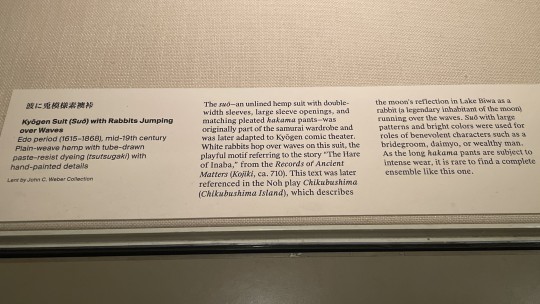
#LunarNewYear #YearOfTheRabbit at the Metropolitan Museum of Art, New York:
Kyōgen Suit (Suō) with Rabbits Jumping over Waves
Japan, Edo period
mid-19th century
plain-weave hemp with tube-drawn paste-resist dyeing (tsutsugaki) with hand-painted details
dimensions: Jacket (a): 31 1/8 × 71 in. (79.1 × 180.3 cm)
"The suō—an unlined hemp suit with double-width sleeves, large sleeve openings, and matching pleated hakama pants—was originally part of the samurai wardrobe and was later adapted to Kyōgen comic theater. White rabbits hop over waves on this suit, the playful motif referring to the story “The Hare of Inaba,” from the Records of Ancient Matters (Kojiki, ca. 710). This text was later referenced in the Noh play Chikubushima (Chikubushima Island), which describes the moon’s reflection in Lake Biwa as a rabbit (a legendary inhabitant of the moon) running over the waves. Suō with large patterns and bright colors were used for roles of benevolent characters such as a bridegroom, daimyo, or wealthy man. As the long hakama pants are subject to intense wear, it is rare to find a complete ensemble like this one."
Photographed on display at the Met's Kimono Style exhibition (catalog entry here).
#rabbit#rabbits#mammals#kimono#suō#Kyōgen#Kojiki#The Hare of Inaba#Chikubushima#textiles#historical costume#theatre#Japan#Japanese art#Asian art#19th century#Metropolitan Museum of Art New York#Kimono Style#exhibition#museum visit#animals in art
17 notes
·
View notes
Photo

Back of a suō (jacket) with a design of lotuses, worn with trousers as a costume for a samurai lord in a kyōgen play
Japanese, Edo Period, early 19th century
resist-dyed and painted plain-weave bast fiber
Metropolitan Museum of Art
0 notes
Text
Deep Cover/ディープカバー
Under
It’s all the same, that worthless dependence
Under
That need for warmth that lowers your defenses
Useless now, and useless then
You're so damn full of it, you're full of it, the worst and
Under
It still won't change, the queen will play her own game
Under
We stay the same, yet stealing for our own gain
Useless now, and useless then
And yet you love them and you're trying to make amends
So weigh the scales in your brain
Show me who’s wrong and take aim
That's why I swore that I would always have your back
Be the fanged hero on the attack
Fixed the problems that you couldn't fix
So why then, oh, why then did it come to this?
Don't stop me! Leave me be!
I need a reason to dish justice, can’t you see?
Inform me and warm me
Give me the solemn purpose I need
Under
Hiding from light, greedy, in spite of your conscience
But in the night, praying the righteous can imprint
Useless now, and useless then
Do you remember what you’re doing this for, instead
Under
He can't be found, chained and bound in his memories
Under
You wanna play? I’ll show you justice with ease
Useless now, and useless then
Let's knock the door down and begin!
So be my reason, be my motivating task
Don't you see? Pity’s just there to distract
Can't you hate evil for what it is?
Can’t you make the choice to not forgive?
Don't stop me! Leave me be!
I need a reason to dish justice, can’t you see?
Inform me and warm me
Give me the solemn purpose I need
Under
Under
I wanna find the justice I’ve been seeking
I wanna crush the evil I’ve been reaping
Useless now, and useless then
Count on me and I’ll defend
That's why I swore that I would always have your back
Be the fanged hero on the attack
Fixed the problems that you couldn't fix
So why then, oh, why then did it come to this?
Don't stop me! Leave me be!
I need a reason to dish justice, can’t you see?
Inform me and warm me
Give me the solemn purpose I need
Let me be! I’m not weak!
Give me the solemn purpose I need
Under
You think you’ve 1, you worthless parasite?
Under
That vulgar slut needs someone 2 hold tight
Under
It’s easy 4 me to see through her lies
Under
5fold suffering, dissecting what is alive
Under
7’s a liar, acting in a kyōgen*
Under
See that warden, that useless eleven
Useless now, and useless then
You all depress me now, you’re all so damn annoying
*Kyōgen (狂言) is a traditional comic Japanese theatrical form that is usually performed in between Nō plays. In Cat, the word kyōgen (狂言) is used to refer to the theatrical form, whereas in Deep Cover, the word used is kyogen (虚言), meaning liar.
#translyrics#vocaloid#lime's translyrics#vocaloid song#hatsune miku#deco*27#milgram#yuzuriha kotoko#kotoko yuzuriha
51 notes
·
View notes
Photo

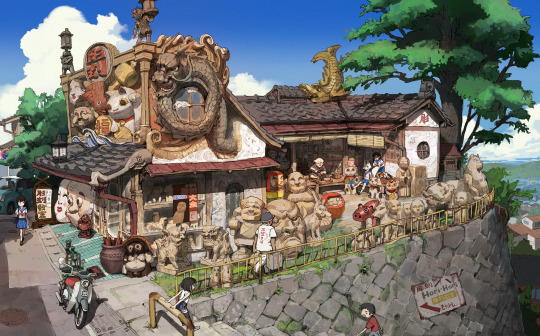
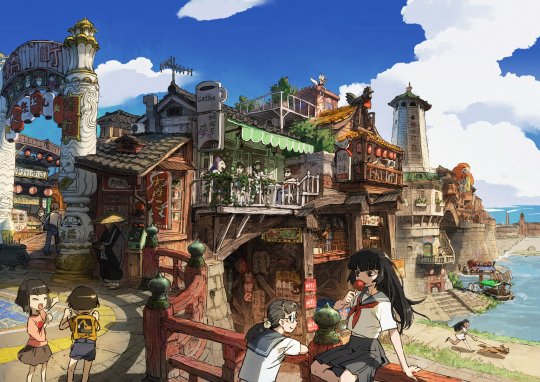

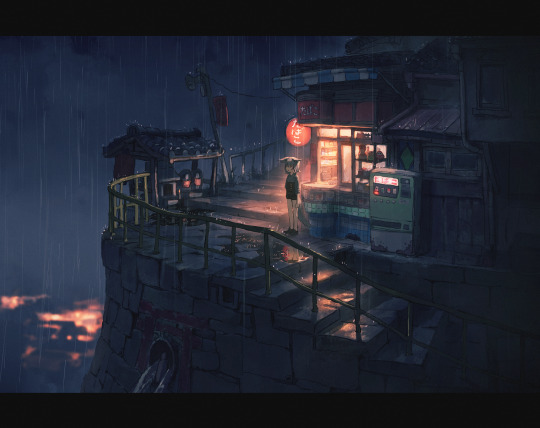
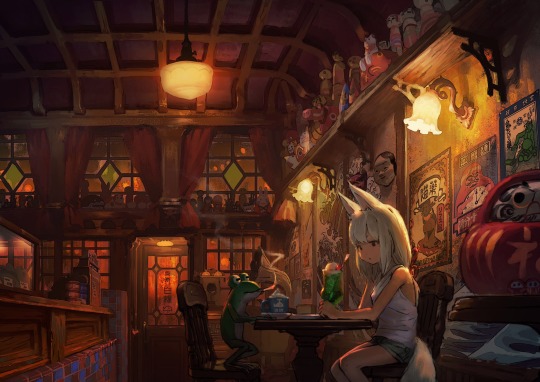
Artwork for the upcoming adventure game Kitsune: The Journey of Adashino, by RIAS.
Since its reveal last year, the it has been showcased in select independent game events with a brief playable demo that has nevertheless managed to attract the attention of the western press. It has also been listed on Steam and is expected to launch in 2024.
Its use of 3D character models over hand-drawn backgrounds evokes the style and atmosphere of late 1990s RPG adventure games, a genre which Japanese developers have allowed to perish to a large extent. The author and lead designer, RIAS, has noted that when contemplating the creation of a game, he opted to embrace the traditional Japanese folklore motifs with which he has been in contact with his entire life. These images attest to this keenness, as seen in the countless references to Shinto deities and iconography, in which kitsune, the fox, is often portrayed assuming the shape of a young woman; together with the presence of many other elements so closely associated with the traditions of Kyōgen and Noh theater.
83 notes
·
View notes
Text
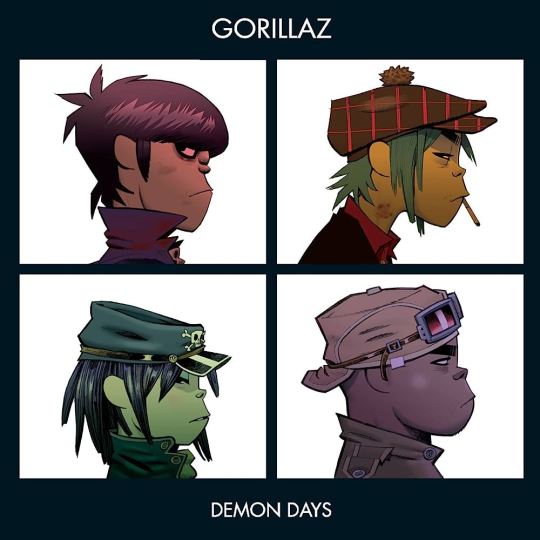


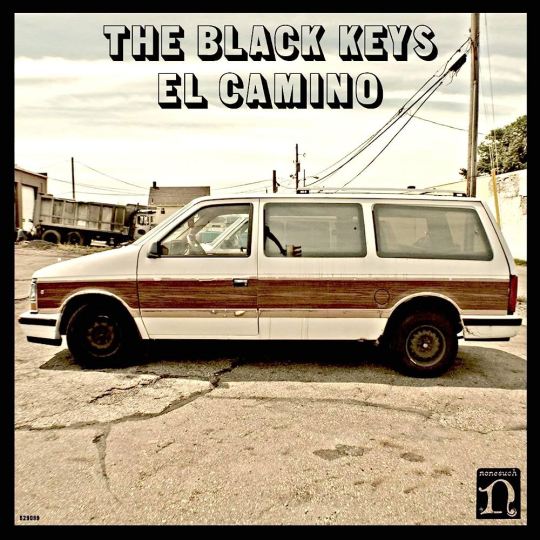



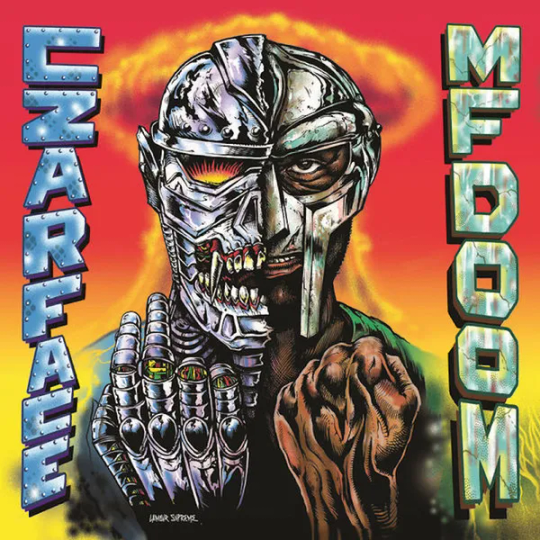

Some of these can change depending on my mood, but I felt like sharing a 3x3 of my favorite albums:
Demon Dayz - Gorillaz
American Idiot - Green Day
Kyōgen - Ado
El Camino - The Black Keys
Random Access Memories - Daft Punk
No One Ever Really Dies - N.E.R.D.
Collision Course - Jay-Z & Linkin Park
Czarface Meets Metal Face - Czarface & MF DOOM
Pax Volumi - Youngblood Brass Band
29 notes
·
View notes
Photo

Small Box (Kobako) with Kyōgen Theater Scene at Mibu Temple in Kyoto. ca. second half of the18th century. Credit line: H. O. Havemeyer Collection, Bequest of Mrs. H. O. Havemeyer, 1929 https://www.metmuseum.org/art/collection/search/58290
#aesthetic#art#abstract art#art museum#art history#The Metropolitan Museum of Art#museum#museum photography#museum aesthetic#dark academia
3 notes
·
View notes
Photo

藤真利子 (Mariko Fuji) - 花がたみ / 鬼狂言 (Hanagatami / Oni Kyōgen)
Region: Japan (Tokyo) / Style: Techno kayō / Year: 1981
LIKED
3 notes
·
View notes
Text
After Joey left I feel slighly melancholic. But yesterday I got very good news that I can return to Norway and still do my masters online!

Here is my new kimono, for autumn. I actually want one more... one which has a very bright color, but the problem is I am tall and finding a kimono (I could always have one specially made, but no time) is almost impossoble.



I went to Ginza as I was to watch Kabuki. I bought my own Nihonbuyo fan and spent a lot of time in cafés meditating about my life.



Kabukiza by day and night. I actually did not enjoy Kabuki at all... I prefer Nōh and Kyōgen forever!


Dessert and sumowrestlers loincloth.
0 notes
Text
Kyōgen Mask: These masks are very similar to Noh masks expect they are less serious. Kyōgen theatre is a type of comedy theather that uses masks designed to make the audience laugh. Most Kyōgen have happy expressions or are extremely distorted.

Bugaku Mask: Bugaku is a type of Japanese dance performance practiced in Japan for centuries. Like Noh or Kyõgen plays, Bugaku needed its artist to wear crafted masks. Bugaku masks were used to portray one of the 20 regular characters in Bugaku. They were traditionally made of cypress wood and covered only the performers face. The expressions were not as exaggerated as in the Gigaku style, and used to have moving parts, such as the chin.

0 notes
Text

Hasimoto Chikanobu (1838-1912), Saruwaka Kyōgen 'The Inner Palace of Chiyoda', 1895
0 notes
Text
Nihongo de asobo. 11, Den deraryū ba [DVD]
New item:

Phrases and sentences cited from songs in dialects, famous Japanese classics and early modern literature are arranged into nursery rhymes that children want to sing along and play with. Children can get familar with rich culture that Japanese-language developped by watching the performances including traditional performing arts such as kyōgen.
Shelf: 699.68 NHK 11 (@ video section)
Nihongo de asobo. 11, Den deraryū ba.
produced by NHK Edyukēshonaru.
Tōkyō : NHK Edyukēshonaru, 2022.
1 DVD (34+5 min.) : sound, colour ; 12 cm.
Originally broadcast in Japan as a television program in 2006.
Not for sale. Limited distribution to Japanese heritage language schools.
DVD (Region ALL, PAL); aspect ratio (16:9); Soundtrack in stereo.
Soundtrack in Japanese. Optional Japanese subtitles available to the song tracks in the main section.
[main section (♪ うた歌詞表示機能付, ※ カラオケ付)]:
1♪※. でんでらりゅうば
2♪※. 藤村の前髪
3♪※. おっと合点承知之助音頭
4♪※. 一茶の雀
5♪. いろは!
6♪※. 諭吉の学問
7♪※. がらぴい
8♪※. ひとみごろ
9♪※. がらぴい (アニメ)
10♪※. 山のあなた
11♪※. かぞえてナンボ
12♪※. かんかんづくし
13♪※. しゃばじゃばじゃ
14♪※. まくらことば
15♪. はるはあけぼの
16♪. まちがいの狂言~ややこしや~
17♪. あいうえうた
18♪. 法螺侍~どうどうけろけろどうぢゃいな~
19♪. ぴっとんへべへべ
[extras]: ● 「でんでらりゅうば」振りのおけいこ.)
#children's television programs#nursery rhymes#japanese language#kyogen#new 2023 01#jteacher#jcentral
0 notes
Text
Kyohei Ishiguro's Bright: Samurai Soul Premieres Stunning New Trailer and Visual, Set for October Release
Kyohei Ishiguro's Bright: Samurai Soul Premieres Stunning New Trailer and Visual, Set for October Release
#Bright #BrightSamuraiSoul #ネトフリアニメ #netflix #anime #イシグロキョウヘイ
Netflix made the announcement yesterday that the Spin-off Series titled Bright: Samurai Soul, based on the 2017 Original Sci-Fi Film Bright, which starred actor Will Smith would be premiering on October 12th. Taking place in Japan from the end of the Edo period to the Meiji period, depicting Izou, a ronin who lives as a bouncer, and Raiden, an orc assassin, who throws themselves into a fierce…

View On WordPress
#イシグロキョウヘイ#ネトフリアニメ#Anime#Bright#Bright: Samurai Soul#Kyohei Ishiguro#Kyōgen#Mansuku Nomura#Netflix#New Spin-Off-Series Announced#October 2021#Sci-Fi#Simu Liu#Yuki Nomura
3 notes
·
View notes
Photo




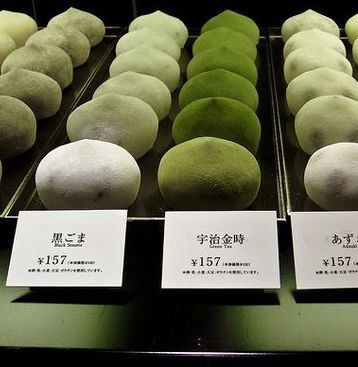
the japanese students
characters copied down with your favorite pen
the vibrant green of high-quality matcha
writing hiragana, katakana, and kanji until the symbols are familiar
strolling through a botanical garden
practicing suffixes, learning the social contexts that determine when different honorifics should be used
the satisfaction of seeing your grasp on the language improve
studying ancient poetry, reading pages of the man’yōshū
a scattering of cherry blossom petals in your hair
watching your favorite shows, recognizing the words and phrases you’ve learned and picking up new ones
recognizing the global influences of japanese culture
busy city streets and neon lights
picking up takeout from your local sushi restaurant
learning to cook authentic dishes
a stack of manga paperbacks with beaten-up corners and broken spines from each re-read
coming up with mnemonics to improve memorization
relishing the challenge of talking with a native speaker
the gently curved roofs of traditional architecture
organized notes, the title written at the top of the page in multiple alphabets
celebrating the theater traditions of noh and kyōgen
analyzing the intersections of japanese culture and contemporary western influences
studying various periods of history, from the Heian to the Meiji
#japanese#japanese student#japanese study#dark academia#dark academia aesthetic#light academia#light academia aesthetic#academia#academia aesthetic#student#student aesthetic#studying#studying aesthetic#studyblr#studyspo
818 notes
·
View notes
Photo

Nō or Kyōgen theater costume (Noshime-type)
1800-1849, Japan
Kasuri (ikat) weave silk
Purchase: William Rockhill Nelson Trus
Nelson-Atkins Museum of Art
233 notes
·
View notes
Note
Happy New Year, Justine. What is the difference between nihon buyo and kyo mai, and kabuki, noh and kyogen?
Nihonbuyō (日本舞踊) is a blanket term for any kind of traditional Japanese dance.
Kyōmai (京舞) is a style of dancing developed in Kyoto.
Kabuki (歌舞伎) is a type of dance that was created in the 17th century for the masses. It's more upbeat and dramatic compared to its Noh predecessor.
Noh (能) is a type of dance that was created in the 11th century for the court nobility. It's very slow and punctuated by small bits of actions compared to its kabuki successor.
Kyōgen (狂言) are small little skits performed between acts of noh plays to liven up the crowd from the slow pacing of the noh dances.
23 notes
·
View notes